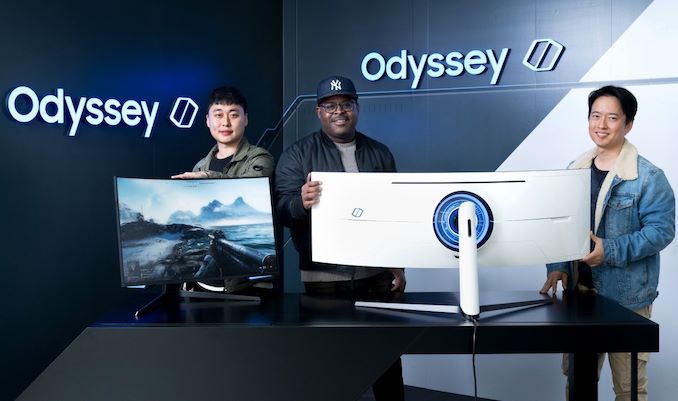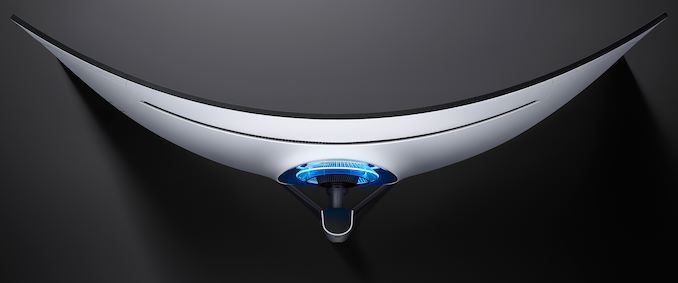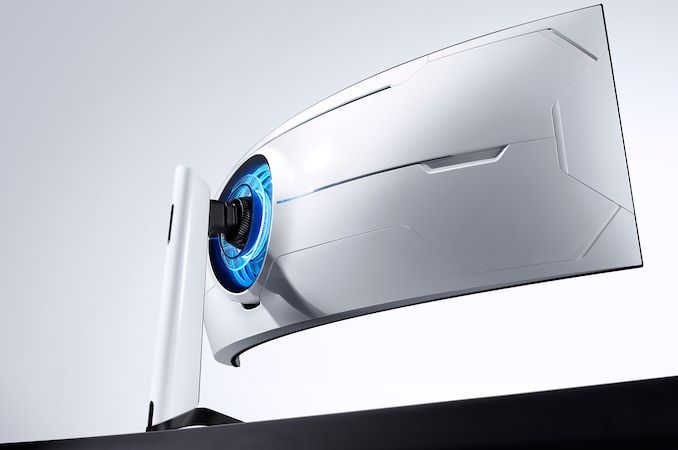Samsung’s Odyssey Continues: Ultra-Curved QLED 49-Inch 240 Hz HDR1000 Monitor w/ Adaptive Sync
by Anton Shilov on January 16, 2020 12:00 PM EST
Nowadays, you can barely impress a gamer with just a curved display. So when Samsung started development of its new Odyssey G9 and Odyssey G7 gaming monitors, it decided to make them ultra-curved, ultra-fast, ultra-bright, and ultra-futuristic. As a result, the new Odyssey LCDs for gamers feature a unique combination of a 1000R curvature, a quantum dot enhanced backlighting, and variable refresh rate support up to 240 Hz.
Samsung’s Odyssey gaming displays lineup includes three models: the 49-inch G9 featuring a 32:9 aspect ratio and a 5120×1440 resolution, as well as the 32-inch and 27-inch G7s featuring a 16:9 aspect ratio and a 2560×1440 resolution. All three monitors use a VA panel with a QLED (quantum dot-enhanced LED) backlighting that enables 600 nits or 1000 nits peak brightness, along with a wide color gamut (see general specifications of the displays in the table below).
From a gamer’s perspective, the key features of the Samsung Odyssey displays are their 240 Hz refresh rate, complete with variable refresh rate support. Samsung's specifications don't make this entirely clear, but it looks like the display uses VESA Adaptive Sync, meaning that it's supported with both AMD and NVIDIA GPUs.
Meanwhile, the monitor also sports a 1000R curvature that promises to enable better immersion when compared to regular curved LCDs.
Since the Odyssey monitors are designed for gamers, they feature an ultra-futuristic design along with LED-based lighting on the back to emphasize features of the design and just follow the general industrial trend.
| General Specs of Samsung's Odyssey Displays with Variable Refresh | |||
| Odyssey G9 49-Inch |
Odyssey G7 32-Inch |
Odyssey G7 27-Inch |
|
| Panel | 49" VA | 32" VA | 27" VA |
| Native Resolution | 5120 × 1440 | 2560 × 1440 | |
| Maximum Refresh Rate | 240 Hz | ||
| Response Time | 1 ms | 1 ms | 1 ms |
| Brightness | 1000 cd/m² | 600 cd/m² | |
| Contrast | high | high | high |
| Backlighting | LED w/Quantum Dots | ||
| Viewing Angles | 178°/178° horizontal/vertical | ||
| Curvature | 1000R | ||
| Aspect Ratio | 32:9 (3.56:1) | 16:9 | |
| Color Gamut | DCI-P3 sRGB |
||
| Dynamic Refresh Rate Tech | VESA Adaptive-Sync (NVIDIA G-Sync Compatible) |
||
| Pixel Pitch | 0.234 mm² | 0.2767mm² | 0.2335 mm² |
| Pixel Density | 108.54 PPI | 91.79 PPI | 108.79 PPI |
| Inputs | DisplayPort HDMI |
DisplayPort HDMI |
DisplayPort HDMI |
| Audio | ? | ? | ? |
| USB Hub | ? | ? | ? |
| MSRP | ? | ? | ? |
Samsung will make its Odyssey G9 and Odyssey G7 displays available sometimes in early second quarter, which is why the company does not publish all specifications and characteristics of the products just now. Prices of the monitors will be revealed at launch.
- Samsung Announces CRG9: A 49-Inch Curved 5K 120 Hz FreeSync 2 Monitor
- Samsung Announces First Freesync 2 Monitors: CHG70 & CHG90 - Quantum Dots, Up to 49”, 144 Hz, DCI-P3
- Samsung Odyssey Z Gaming Notebook: Going For Gamers with 8th Gen and Max-Q
- CES 2019: Samsung Announces The Notebook Odyssey
- Samsung Announces Updated Notebook 9, Odyssey, and Chromebook Plus/Pro
Sources: Samsung Canada, Samsung India, Samsung U.S., TFT Central














31 Comments
View All Comments
TEAMSWITCHER - Thursday, January 16, 2020 - link
LG demoed a 48" CX OLED TV at CES, with 4K @ 120Hz support, HDMI 2.1 with VRR, and Dolby Vision (HDR.). You also get a Apps, Speakers, Ethernet, 802.11ac, Bluetooth 5.0, and a remote.The PC Display Industry is dead to me.
chris.london - Thursday, January 16, 2020 - link
And by this time next year we will be able to get it for less than $900. I wonder how Acer/Asus/Samsung will be able to justify their high prices.p1esk - Thursday, January 16, 2020 - link
If that 48" was 8k @ 120Hz (two DP1.4 cables with DSC), and highly curved (1000R) - that would be my dream monitor. I'd pay $3k for it today.p.s. zero interest in gaming.
r3loaded - Thursday, January 16, 2020 - link
With one stroke at CES 2020, LG's OLED48CX TV have completely obliterated the market for high-end PC monitors. Why pay so much for smaller, extremely expensive G-Sync Ultimate LCD monitors when they're offering a superior display with incredibly low input lag and near-instantaneous pixel response times? And, as you mentioned, it's also a TV with all those goodies included.The rest of the market needs to cut their prices drastically or offer equivalent specifications. Or just buy that OLED panel off LG and make something equivalent at an equal or lower price.
FXi - Friday, January 17, 2020 - link
Moreover, while you are getting 120Hz support and VRR you get a pixel response time 10x faster than even these 240Hz monitors. I'm not saying you can drive it that high, but the 48" OLED panels (and I pray 43" might be considered eventually) are going to make it so only going higher resolution will save TFT panel sales. Have to see how the promise turns out in real world testing but eventually even Samsung will be selling their variation on OLED (blue with QD layer) and at that point TFT's will become the 2020's version of the CRT.lilkwarrior - Saturday, January 18, 2020 - link
Yeah, the PC monitor manufacturers have extremely poor product design or product research teams making moronic decisions.Only monitors really of note upcoming this year are monitors w/ 4K, HDR1600, Dolby Vision HDR, HLG HDR, 1600nits, & HDMI 2.1 (or at least HDMI 2.1 features) like LG's PA32UCG.
Most monitors this CES have been trash for enthusiasts & content creators.
imaheadcase - Thursday, January 16, 2020 - link
You can drive them properly now. Unless you mean getting up to that 240Hz spec. But you won't even get that with next gen cards.nevcairiel - Thursday, January 16, 2020 - link
Of course "properly" means at full spec. No chroma subsampling, no DSC, full 10-bit for HDR, full resolution, full refreshrate.imaheadcase - Thursday, January 16, 2020 - link
Samnsung and sony do that i think. I forget which one, but that got own sound branding as well. It sounds really really good though.Ryan Smith - Friday, January 17, 2020 - link
I can't confirm whether the HDR performance is going to be weak. But at a minimum, yes, if the monitor was DisplayHDR 1000 certified, I would have expected Samsung to list that instead. DisplayHDR certification involves a good deal of time and money, so vendors have every reason to show it off if they have it.